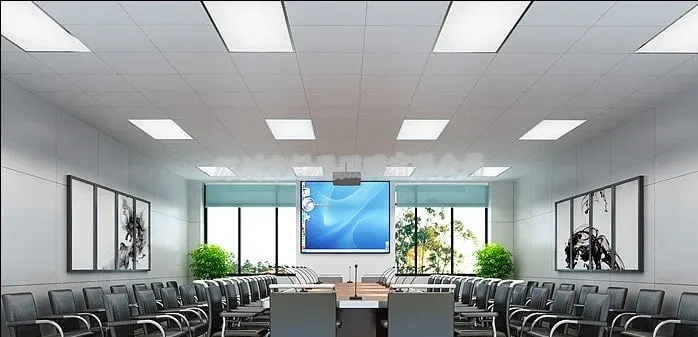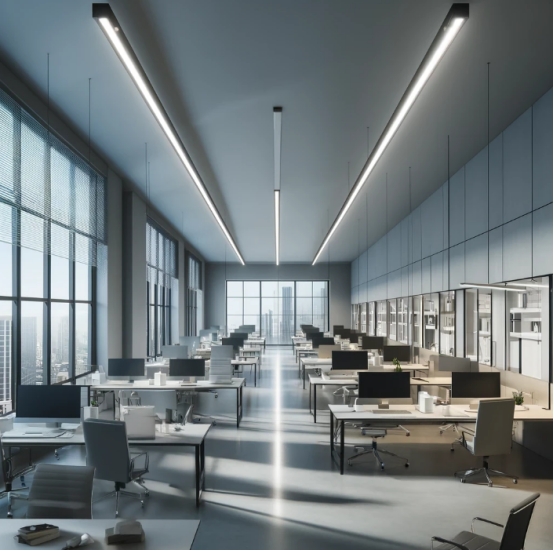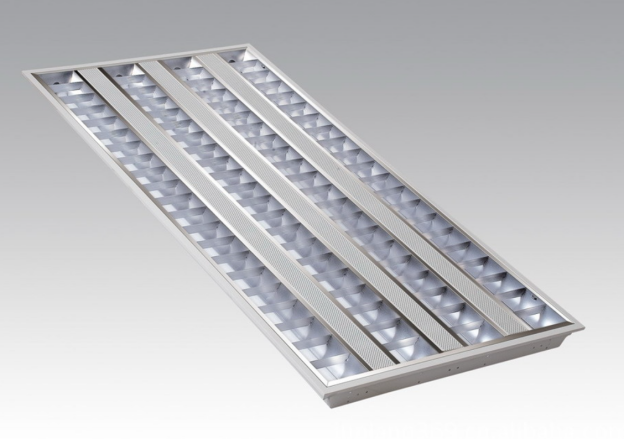There are a variety of solutions available on the market today, but two of the most popular ones are DMX (Digital Multiplex) and DALI (Direct LED Analogue Interface).
In this article we will explore these two technologies to help you decide which one is best suited to your needs so that you can choose wisely when planning out any lighting project.
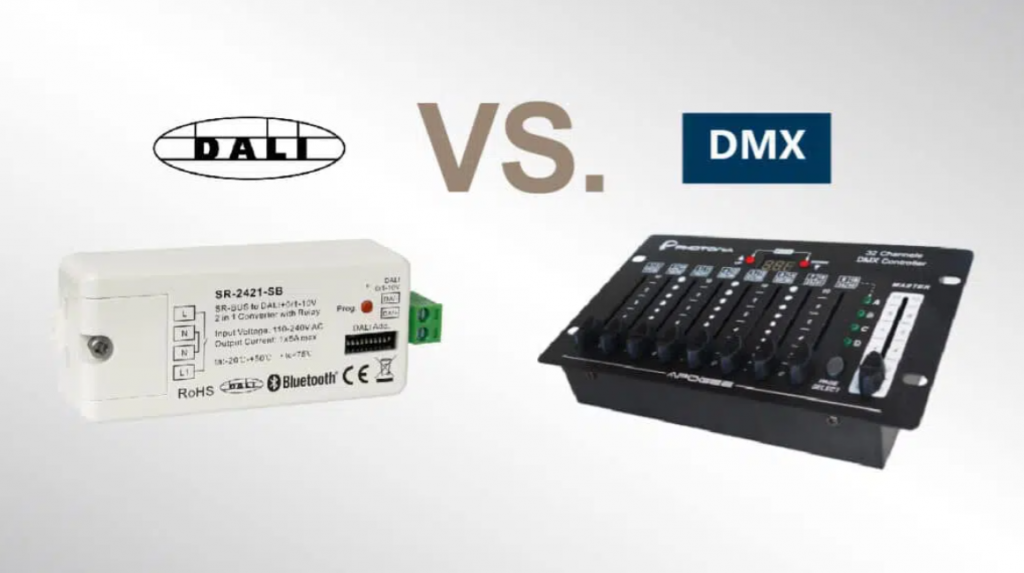
What Is DMX?
DMX is a protocol that allows users to control all lights with one controller, providing access to features such as dimming or fading effects via sliders and switches using the DMX console hardware.
How DMX Works?
The DMX protocol works by sending “packets” or messages from the console to individual lights (or dimmers) connected on a network.
This is done through standard cables that run between each light fixture, as well as lamps for linear runs and multiplexers for added flexibility in control options.
Advantages Of Using DMX:
1. Affordability:
It is one of the most cost-effective lighting control systems, as each light can be controlled individually without needing an extensive wiring setup or extra hardware components like relays/switches to turn individual lights off and on in a certain pattern or order.
2. Versatility:
With its flexibility in both architecture (for large-scale installations and projects) as well as individual light control, DMX is a great choice for both large complex environments and smaller one-off setups.
3. Compatibility
Since the protocol has been around since 1986, it is widely supported by many lighting fixtures/manufacturers making integrating them easier into existing systems with no additional compatibility issues present.
4. Flexibility & Scalability:
Whether needing to set up multiple animations (for example in theme parks), synchronize lights on stage performance or simply adjust brightness & dim levels, DMX provides users with the capability to control lighting effects at multiple points.
Examples Of How It Is Used In Practice:
1. Theatre & Performances:
DMX is used to dynamically change the colours, intensity levels and sequence of sequences during over a certain period; offering directors with more creative freedom in their artistry.
2. Theme Parks:
When most guests enter into an attraction for example rollercoasters or ghost-buster like mazes, specific lighting effects are usually synchronized together through several light sources – something only achievable using this system due to its scalability capabilities from scene transitions up till multiple locations/areas.
3. LED Panels & Video Wall:
Multiple video wall displays, either for advertising or showing streams of information/content is made easier using DMX as each display can be turned on and off individually with just one controller instead of having utilize extra hardware; saving time when setting up these large amounts of screens in tight spaces!
What Is DALI?
DALI is a digital lighting control protocol. Developed by the Digital Illumination Interface Alliance in 2006, it standardizes powering, controlling, and monitoring LED lights. These lights can communicate with other DALI-enabled devices within the same network.
Main advantages of using DALI are low power consumption, fast response time for dimming, and controllability over large networks. Individual basis control is also possible. Compared with traditional analog lighting systems, DALI offers greater compatibility.
Network components and more efficient LED lighting systems are also improved. By providing better control over individual LEDs, decorative patterns can be created. These patterns can be used in retail spaces or galleries.
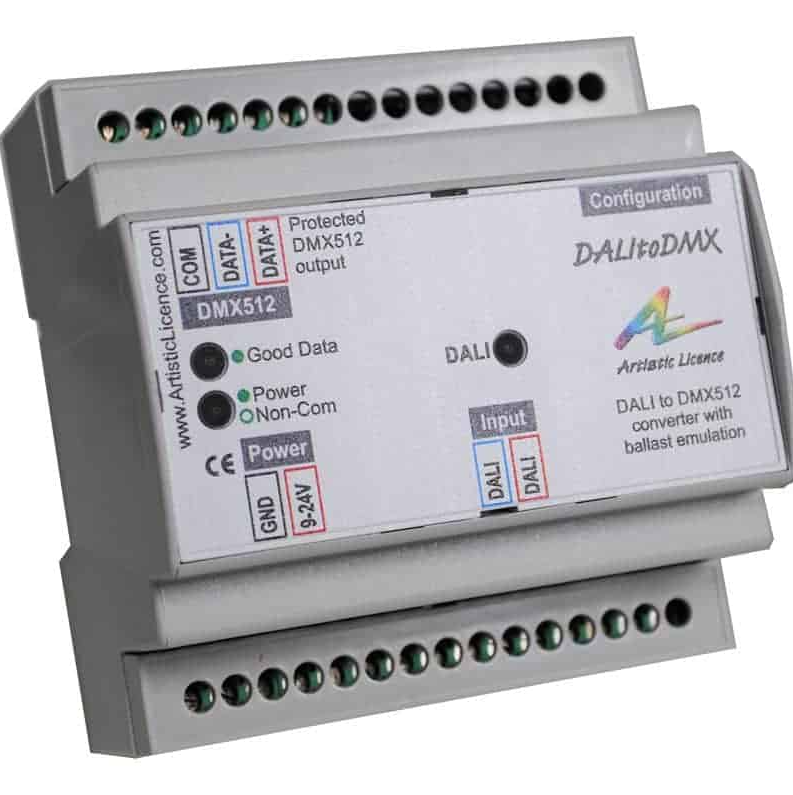
How Does DALI Work?
DALI sends electrical signals over a two-wire circuit. This allows communication between the light control system and individual LEDs. Other DALI-enabled devices are also part of this communication. Users can send commands like dimming levels and on/off times.
The communications protocol is based on IEC62501. It specifies data encoding and transmission across the connection. All connected devices can understand this connection.
Power is provided across the network. Each device or LED light can be individually controlled and monitored. This depends on the system setup.
Advantages Of DALI!
1. Greater Control & Flexibility:
Individual controllability of each LED is enabled within a light panel or area. Users can create attractive and decorative lighting patterns. Greater aesthetic value can be added in applications such as retail spaces or galleries.
2. Increased Efficiency:
DALI offers improved power efficiency compared with traditional analog systems. Users have better control over power consumption in the system overall.
3. Easier to Setup:
Fewer wires are needed for setup when using DALI as a lighting control system. Installation and maintenance are easier.
4. Scalable:
Number of devices or lights controlled with one network is not limited by the protocol. This solution is particularly useful for applications like large scale sports arenas with many lamps needing control.
5. Greater Compatibility:
DALI uses IEC 62501 communications standards. Better compatibility between components from different manufacturers is offered. Increased system longevity and cost efficiency result.
Examples Of DALI In Use!
1. Art Gallery Lighting:
Controllability of individual LEDs within panel lights is allowed. Art curators have an improved way to manage how different works are highlighted. Too many shadows spoiling pieces on display can be avoided – all from one controller!
2. Stadiums & Arenas:
DALI is suitable for large stadiums or sports arenas due to its scalability and low power consumption. Many lights need controlling quickly and with great ease.
Similarities Between DMX And DALI
Both protocols allow digital signals to be sent from a controller. Typically, this is done via Ethernet to receivers. These receivers can then convert the signal into instructions.
Connected LED lights or other hardware, such as sensors and dimmers, use these instructions. In many cases, both systems offer bidirectional communication. Feedback from devices being controlled is sent back to the controller.
This allows for better monitoring of operations. Dynamic programming changes can be carried out based on data received from connected devices. A few similarities between the two systems are:
- Functions such as dimming, color mixing, and scene setting are available. An advanced level of flexibility is provided when choosing how a space should be lit up.
- Addressable devices can easily be added/removed with either system. No need to program each device into the controller. This saves time during installation.
- Digital communication between controllers is more reliable than analog systems. This means fewer errors or component failures.
- Integrating automated task programming is easier. Complex lighting changes can be made with just a few lines of code.
- Both systems offer reliable communication between various devices. They utilize a standardized protocol and structure on the network. Source code written for one system can easily be ported over when switching from DMX / DALI. No hardware change needs applying.
- Bespoke solutions are possible. 3rd Party Application Programming Interfaces (APIs) can be used with both DMX and DALI Systems.
Differences Between DMX And DALI
DMX and DALI differ in features, capabilities, and use cases. One system may have advantages over the other, depending on specific needs. Application or project requirements can influence this choice. Some key differences between them are as follows:
Features And Capabilities
DMX allows for more detailed control over lighting fixtures. Finer gradations are possible than with DALI. Achieving a certain look or atmosphere in an indoor space can benefit from this. Basic lighting functions like on/off may not require such detailed control.
A major difference is DMX’s ability to connect various light types. Fluorescent lamps, LEDs, and halogens can be connected. In contrast, DALI is designed only for dimmable LED-based lighting products.
Use Cases
DMX has a relatively broad range of use cases. From dynamic stage shows to complex multi-room installations, it has many applications. However, for integrated control solutions across larger buildings or campuses, DMX is usually not feasible.
That’s because it isn’t easily scalable.
Systems using DALI can be scaled up quickly through networks. Thus, DALI is often more suitable for larger applications.
DMX tends to require a great deal of wiring.
In contrast, DALI relies on bus cable networks. This makes DALI faster and easier to set up. When it comes to maintaining large lighting installations, DMX can be increasingly difficult. Its complexity means system changes or replacements need an experienced technician.
On the other hand, many MANAGEsystems are far simpler. This reduces maintenance costs and the potential for costly mistakes.
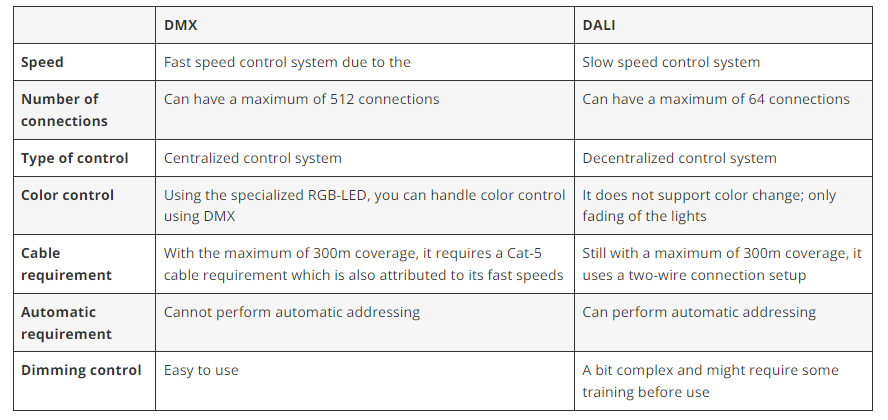
Application Areas For DMX And DALI
DMX and DALI have become widely used in many applications. Their popularity is due to their ease of use, scalability, and compatibility with other systems. Additionally, they are low cost.
Examples Of Applications For DMX And DALI:
1. Home Lighting:
DMX and DALI provide users with the ability to quickly adjust brightness levels.
Users can dim lights when it is time for bed or customize room-by-room light intensity settings. These settings are for different locations throughout the house.
2. Retail & Commercial:
DMX and DALI can work hand in hand with video walls and projectors. Retailers can use them for efficient lighting control over various display units, showrooms, or entire stores.
They are also a great option for commercial settings like offices and workspaces. Precise light levels help maintain the desired ambiance of each space.
3. Outdoor & Landscape Lighting:
DMX and DALI can be installed into outdoor spaces. Their hard-wired components make them more suitable for dealing with varying environmental conditions.
They are a better choice than other systems like Wi-Fi networked LED panels lights. Wi-Fi networked lights may be more susceptible to changes in weather.
4. Stage & Theatre:
These setups are used during music concerts or theatrical plays. Spotlights on stage actors are needed. Other effects include flashing lights and color washing backdrops.
Explanation Of Which System Is Better Suited For Specific Applications!
DMX and DALI both provide suitable solutions to many lighting projects. Each system has its advantages based on application requirements. If more flexibility or scalability options are desired, multiple separate controllers may be necessary.
In this case, DMX is favored due to its greater connectivity options. DALI systems usually need one master controller unit per system set-up.
If a cost-effective solution is preferred, DALI is seen as the more ideal choice. DALI does not need extra hardware or costly specialist equipment like DMX systems.
Real-World Examples Of How DMX And DALI Are Used In Different Industries!
1. Large Scale Manufacturing:
Automotive industry heavily relies on automated production lines. Robots need precise illumination levels for optimal operation. Accurate lighting control systems are essential. DMX and DALI technology offer such control systems.
2. Public Spaces:
DMX is the preferred choice for airports and train stations. Any other public domain requiring a high level of security benefits from DMX. Reliable lighting control systems ensure seamless operations. Operations continue day in and day out.
Applications such as theme parks can use these two solutions. They can be used when needing blackout illumination or colorful light shows. These shows attract passersby’s attention. They also engage them within its settings all at once.
3. Education:
Classrooms and labs operate in educational facilities. Facilities include universities and community learning centers. They find great benefits in using DMX and DALI systems.
These systems manage LED panel lights. They provide educators the ability to customize classroom lighting intensity. Customization depends on ongoing tasks.
Factors To Consider When Choosing Between DMX And DALI Lighting Systems!
Should you use DMX or DALI? Both are advanced technologies. They have been around for several decades and offer a number of advantages. We will discuss various factors for decision-making below.
1. Budget Considerations:
When looking at a budget for lighting control system, important aspects include hardware costs and installation labor costs. DMX is simpler than DALI systems and may have less upfront cost.
However, comprehensive installs might require more time for installation or troubleshooting. This holds true for any type of setup, even advanced DALI systems.
2. Scalability Of The System:
DMX is a great choice for projects requiring scalability due to its abundant hardware and software options. These options can be added to create complex lighting setups with large numbers of dimmable circuits.
On the other hand, DALI offers flexibility but might not require as much physical space. It might not provide as many control points when compared to advanced DMX products like Art-Net relays or digital ballasts. For larger installations, DMX proves to be a more reliable choice.
3. Specific Needs Of Application:
Another key factor to consider when deciding between DMX and DALI systems is their suitability for specific lighting requirements.
If precision dimming control in limited space with multiple zones is needed, advanced all-in-one solutions like those manufactured by OlamLED could be preferable. Such solutions support both types of protocols and offer superior features along with a more robust interface.
When parsing through all the available options, consider both budget constraints and particular needs. If in doubt, contact OlamLED today. Our experts can help provide insights or guide products to fit your requirements.
Conclusion:
Discussing similarities and differences between DMX and DALI is important. It allows you to make an informed decision on the right lighting control system for your project. Both systems offer valuable features. Consider budget, scalability of the system, and specific needs when choosing. For a reliable supplier of LED panel lights or more information about DMX or DALI systems, request a quote from OlamLED today.
